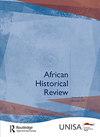“Little More than Rich Soil?”: The Anatomy and Politics of the Cape Bat Guano Trade, 1890–1920
IF 0.1
Q3 HISTORY
引用次数: 0
Abstract
Abstract The bat guano trade, although a small, localised, and secondary enterprise was as significant for the nineteenth and early twentieth century Cape fertiliser trade as its more lucrative and prominent counterpart, the seabird guano trade. Located in relatively inaccessible and geographically dispersed caves on the Southern Cape coast and following a long struggle to be acknowledged as a useful fertiliser, the product became part of and contributed to the generation of continuous conflict between the colonial authorities, local farmers, and entrepreneurs about cheap guano. Aided by farmer-politicians, bona fide farmers and horticulturists continuously agitated for access to a cheap fertiliser while local businessmen with an interest in deriving some income from its exploitation fought for the right to free and unrestricted access to the resource. Resolution of this matter became far more difficult with the dawn of the Union of South Africa where the need to integrate new discoveries in Transvaal resulted in the need for a national policy and a central administration as well as common quality standards. Although relatively low-key and less dramatic, the battle for access to bat guano mirrored that of the seabird guano trade. This article attempts to properly contextualise this branch of the international guano trade and to describe the dynamic interaction between the conflicting parties around matters such as access, policy, and profit. In this regard, it explores and tries to make sense of both the mechanisms used and compromises concluded to ensure the workability of the system during the first two decades of the twenty-first century.“只不过是肥沃的土壤?”:1890–1920年巴特关诺角贸易的解剖与政治
摘要蝙蝠鸟粪贸易,尽管是一个小型的、本地化的二级企业,但在19世纪和20世纪初的开普化肥贸易中,其重要性与更有利可图、更突出的对手海鸟鸟粪贸易一样。该产品位于南开普省海岸相对人迹罕至、地理位置分散的洞穴中,经过长期的努力,被认为是一种有用的肥料,它成为殖民当局、当地农民和企业家之间关于廉价鸟粪的持续冲突的一部分,并促成了这场冲突的产生。在农民政治家的帮助下,真正的农民和园艺师不断鼓动人们获得廉价化肥,而有兴趣从化肥的开采中获得一些收入的当地商人则为自由和不受限制地获得资源的权利而斗争。随着南非联盟的成立,解决这一问题变得更加困难,因为需要整合德兰士瓦的新发现,因此需要一项国家政策、一个中央行政部门以及共同的质量标准。尽管相对低调,也不那么引人注目,但蝙蝠粪的争夺战反映了海鸟粪贸易的情况。本文试图将国际鸟粪贸易的这一分支恰当地置于背景之下,并描述冲突各方之间围绕准入、政策和利润等问题的动态互动。在这方面,它探讨并试图弄清楚为确保该系统在二十一世纪头二十年的可操作性而使用的机制和达成的妥协。
本文章由计算机程序翻译,如有差异,请以英文原文为准。
求助全文
约1分钟内获得全文
求助全文

 求助内容:
求助内容: 应助结果提醒方式:
应助结果提醒方式:


